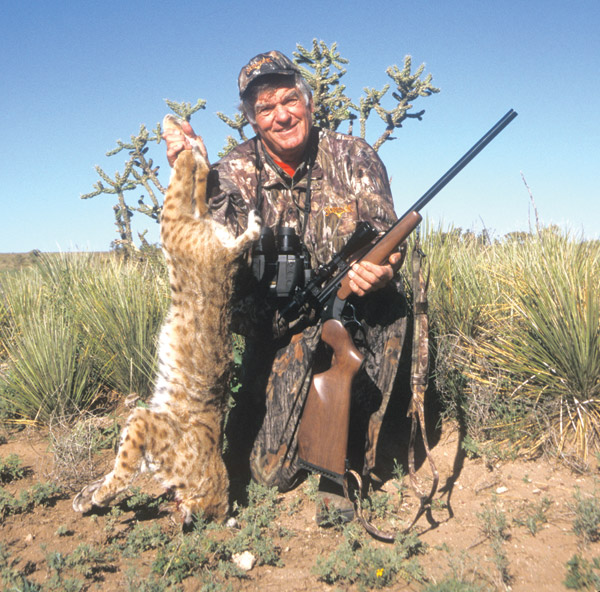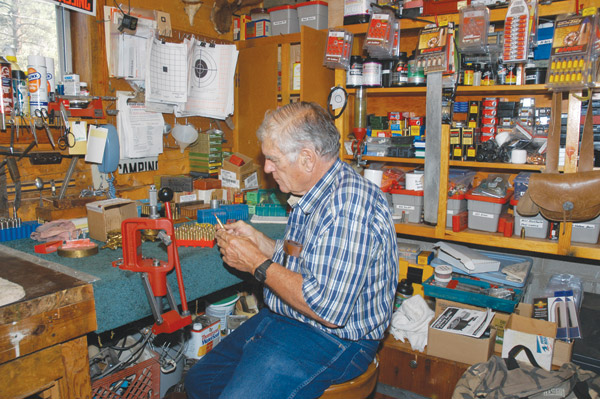 Predator Hunting: Pelt Saving Bullets
Predator Hunting: Pelt Saving Bullets
By Predator Hunting Editor Judd Cooney

The coyote slowed to a walk then stopped and sat down some 300 yards away. I cut the volume on the digital FoxPro caller and switched from Lightning Jack squalls and screams to more subtle mouse squeaks. The coyote pricked up its ears but didn’t move.
Not a good sign. Maybe it already had encountered a predator caller earlier in the season, or maybe it had just got its butt kicked by a really tough jackrabbit. Either way, it wasn’t coming any closer.
Fortunately for me, and unfortunately for that sitting coyote, my .220 Swift was dead on at 300 yards and resting on a rock-steady bipod.
The 52-grain Sierra hollow-point boattail bullet caught the big dog through the shoulders and flattened it in the snow.
Two hours later, I was sitting in the shadow of a low cedar, off to the side of the mouth of a brush-choked canyon that emptied into a relatively open area interspersed with Ponderosa pines and clumps of oakbrush. Quieter but still ear-piercing cottontail distress sounds were coming from the same electronic caller, only this time the caller was hanging on a branch over my head.
The first series of squalls was still emanating when a large tom bobcat came bounding out of the brush and stopped right in front of me at 30 yards.
Bobcats are supposed to sneak in slowly, but apparently this one decided to throw caution to the wind.
It almost caught me off guard—almost, but not quite. A couple of seconds later, the big cat was down for the count, shot through the shoulders with the same 52-grain Sierra HPBT.
A coyote at 300 yards and a bobcat at 30 had both been shot in nearly the same place with the same bullet, a bullet that left the muzzle at around 3,700 feet a second. Both had dropped on the spot, but the fact that neither pelt had suffered serious damage was the best part.
One might expect a bullet at 300 yards to have slowed to the point of under-expanding and doing little damage; one might also think the same bullet traveling at close to maximum velocity at 30 yards would obliterate everything betwixt tail and tonsils. Neither happened.
Careful bullet selection matters when hunting predators, especially when you want to save the pelts.
I started reloading in high school, but it wasn’t until I got to college and spent summers roaming over western South Dakota with its millions of prairie dogs and western ground squirrels, or “flickertails” as they were commonly called, that I really got into reloading.
I had the time and the incentive to experiment with load and bullet combinations, looking for accuracy and peak performance at long and short range. I read everything I could find on reloading.
At the time, I hunted with a custom cartridge that consisted of a .243 Winchester case necked to .22, very similar to the .22-250 that was still a relatively new wildcat at the time. I also shot a .222 Remington and a 6mm Remington that I’d built from the barreled action up.
My main concern was long-range accuracy, and I spent hours at the bench working with different cases, primers, bullets and powder combinations.
Like most young hunters, I’d grown up with a rimfire .22 Long Rifle, and I’d learned that I wanted a solid bullet when hunting rabbits and squirrels for the table. The hollow point was good for obliterating gophers, prairie dogs, jackrabbits and crows, but it tore up the meat.
Yet, when I got into reloading centerfire .22 ammo, I quickly realized that the copper-jacketed hollow point was not the most explosive at higher velocities—quite the contrary, in fact.
With these loads, the hollow-point configuration was used to get the center of gravity back toward the center of the bullet for better balance. Adding a boattail to reduce drag made it the most accurate of long-range bullets.
Soft lead tips, or spitzers as they were called, were the truly explosive bullets. The gilding metal or copper swaged around the soft lead core left just a pointed lead tip exposed. When this bullet hit, the lead mushroomed back inside the thin copper jacket, literally exploding the bullet. Which was great for varmint hunting. Many a prairie dog, flickertail and jackrabbit met its maker due to the explosive quality of those fast-moving lead-tipped spitzers.
When the local fur buyer started buying jackrabbits, priorities changed. They made felt from the pelts, ground the meat for mink feed, and paid $1 each for the big prairie hares.
I could easily get 15 to 20 jacks on a good afternoon after school, double that on weekend days when I provided cheap .22 rimfire ammo and hamburgers to a couple of local high school kids who pushed through shelter belts while I sat at the end picking off the escaping jackrabbits.
Once on my best stand, located at the end of a 100-yard-wide and mile-long shelter belt, I shot 44 jackrabbits. Not a bad way to make a buck.
On a sunny afternoon, there might be a half-dozen or more jackrabbits lined out along a drifted fence line or shelter belt. I’d start with the closest and move outward, picking them off where they sat. On a number of occasions, I shot a half-dozen jacks from the same location.

The .222 made short work of any jack out to 200 yards. From there to 400 yards, and occasionally farther, the .22-243 did the job. But those soft-point spitzer bullets were doing too much damage, and even though I got to where I could sew up a seemingly undamaged jackrabbit out of a head, tail, and a couple handfuls of hair, I figured there had to be a better bullet for the job. Jackrabbits in sundry pieces and parts only paid 25 cents.
I tried several full-jacketed bullets, but they zipped through, and the tough prairie hares sometimes managed to get back down their snow burrows before expiring. This necessitated digging them out, and some of the snow burrows in the drifts along fence lines ran 20 feet or more.
I tried swaged solid lead bullets, but they had to be loaded down in velocity, which negated both the long-range accuracy and stopping power.
I started experimenting with match-grade hollow points, and eureka!
The heavy jackets prevented fragmentation but still allowed the forward portion of the bullet to banana peel back, delivering plenty of knock-down punch without the explosiveness of the soft points.Pinpoint accuracy, lethal impact, and little pelt damage. Who could ask for more?
Sierra bullets performed best in my rifles; the 52- and 53-grain became favorites for varmints and predators.
Later, while I was in the Army, I spent most of my down time building rifles, reloading, and making use of the shooting facilities available at Fort Carson.
There were several huge prairie dog towns on the base, located smack in the middle of the bombing range. Every time I hunted, I had to get range clearance so some jet jockey from Denver or Omaha wouldn’t use me for a strafing or rocket target. Also had to be wary of the unexploded ordnance on and in the ground.
It certainly added an edge to shooting prairie dogs.
By then, I’d traded the .22-243 for a pre-1964 Winchester Model 70 in .220 Swift. I added a new Shilen barrel and laminated walnut stock.
The Sierra 52-grain HPBT was the most accurate and dependable bullet in this rifle, too. Several new .222s also shot one-hole groups with the bullet.
My favorite big game/varmint rigs at the time were a pair of superbly accurate 6mm (formally .244 Remington) rifles built on Sako actions. For varmints and predators alike, I loaded Sierra 85-grain HPBT, a superbly accurate bullet with exceptional long-range stability.
It dropped coyotes, fox and cats without overly damaging the pelts, unless I happened to center-hit a critter with a full belly. Then, the energy of the 6mm and the hydrostatic shock of the internal liquids made for a lot of needlework repairing pelt damage.
For big game with the 6mm, I settled on Nosler 100-grain spitzers.
When I went to work for the Colorado Division of Wildlife, I found healthy populations of heavily furred Western coyotes, red fox and bobcats in the mountains. Making clean kills at all ranges with minimal pelt damage became even more important, and I kept on experimenting to find even better bullets.
I’d added a couple of .223s and .22-250s to the arsenal, and I worked up the best fur-taking loads for all of them.
By that time, technology had advanced considerably, and the bullets were far superior to earlier offerings, both in accuracy and terminal performance. The lead-tipped spitzers were a thing of the past, replaced by sleek, polymer-tipped projectiles.
Depending on the thickness of the gilding metal jacket in the neck and shoulder, such bullets can be made to expand explosively on contact or to penetrate with controlled expansion.
By then, premium factory ammo was also being loaded with better bullets, in some cases on a par with my reloads.
Federal, Remington, Winchester and Hornady all made varmint and predator cartridges that were far better than what could be had just a few years before.
When Winchester announced a Supreme in .220 Swift, I couldn’t wait to shoot it. I’d been using Winchester Supreme in my big-game rifles with great results. I couldn’t believe it, however, when I learned they were loading it with a 40-grain bullet. Granted, it smoked at 4,000 ft/s and was supremely accurate, but this type of loading was what killed the .220’s popularity 60 years before. Evidently, Winchester hadn’t learned a thing.
It didn’t take long to relegate the new Supreme .220 Swift ammo to prairie dog town, where the devastating effect was actually welcome.
At about the same time, Federal brought out a .220 Swift load with a Sierra 52-grain HPBT that left the muzzle at about 3,700 ft/s, a deadly accurate and fur-friendly combination. They’ve since switched to the 50-grain Sierra BlitzKing, which is not nearly as fur friendly but still superbly accurate.
Federal also makes a number of premium loadings for the .223 and .22-250, opting for the 55-grain Sierra GameKing HPBT over the 52-grain, a slight change that still makes a good predator load, accurate with minimal pelt damage.
Hornady’s best .223 predator cartridge is their match loading, which utilizes a 53-grain HP match bullet. I’ve used this for everything from gophers to coyotes at long range, and it works like a charm, deadly accurate and fur friendly.
Hornady also produces several fine predator loadings in .22-250 and .220, but my handloads using their 52-grain HPBT bullet and 52-grain A-Max bullets still outperform them in my rifles.
Remington has entered the market with premium loadings for .223 and .22-250 using 50-grain Accu-Tip polymer-tipped bullets. They are superbly accurate but a bit on the hot side for saving pelts on close shots, especially with lighter-skinned critters like fox and cats.